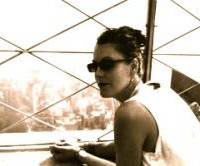We are caught you, me, all of us—in a hopeless entanglement, a quantum entanglement.
We are fragile daisies in an iron chain, strung painstakingly by the hands of children at a green painted picnic table behind a Victorian house by a lake that we loved but can never find again. Our mouths bear the stains of countless red lipsticks long dissolved in the pockets of once favorite clothes ruined in the wash. Our hands tremble with passion for the violin we either played beautifully or stepped on accidentally during the year of the terrible divorce. We have no taste for piles of small talk and we devour them greedily.
It doesn’t matter and it does matter and we are here to accept both of truths at once, our illusory separateness and our inevitable oneness.
Quantum physics tells us unequivocally that your particles are mine and mine are yours. Before long, science will also prove, just as the Buddhists always knew, that you are me and I am you.
Actually, science has already shown this in all the ways that matter. Our thoughts, ideas, and personalities, our memories, passions, and our shattered bits are all real, but they don’t reside in any literal physical space. These intangible facets of energy are known as quantum information. And quantum information, say scientists, can get intertwined with other quantum information.
My stuff mingles with your stuff.
Albert Einstein called quantum entanglement “spooky at a distance”—referring to how all types of particles can become linked and instantaneously influence one another from a distance. My bad dream is your broken heart. And when two particles are entangled, they stay that way, no matter how far apart they get. Information still passes between them instantaneously. This is science. It is as real the ugly scar on my knee that has since vanished, or the ship to a different future that I did not board, or the heart tapping steadily under my ribs.
Isn’t this understanding responsible, in part, for why I no longer regret Bob, the older, pot-smoking manager I used to sleep with when I was a confused, lonely college student canvassing for healthcare rights and the environment?
Wasn’t Bob, with his blunt mustache and his tobacco stained fingernails, just another particle of quantum intelligence about myself in that particularly befuddling time and place? Whether Bob should have seduced me (and the concept of seduction could not be more loosely applied) is, for the purposes of this discussion, beside the point. The point is that it’s possible, likely, and indeed inevitable that every encounter we have is in essence another encounter with ourselves.
None of us can exist without all the others. We know this. But breathe a little deeper and open to this shimmering truth: each of us is all the others. There are no others.
As Brother Phap Niem explains: “Inside of you, you can find everything. There is only one thing you do not contain— a self.” This is the wild terrain that calls to me: the rutted, weedy stretch of dirt road between my life and somebody else’s, the space in which we are as much the one as the other.
Sometimes, we feel this oneness like thunder, like sleet, like sun on our arms, like our daughter filling up our heart just as the phone rings and it’s her. We feel our friend’s heartbreak as our own or know what our father is going to say before he does. The wrenching news rises as a dull ache in our belly before it’s ever delivered. This happens most often with those we are closest to, because the more quantum information that’s entangled, the deeper and wider the effect. When we think of these people with emotion, our message comes through instantaneously.
Practice this with intention and you may be surprised by the uncanny results of your thoughts. Thoughts are feathers, pine needles, gasoline, sex. Thoughts are butcher knives and clay, unopened umbrellas, blood. Thoughts are buttered popcorn and mildewed books and funerals in empty churches filled only with prayer.
Thoughts are consciousness, and consciousness creates all things. Einstein and other scientists have proven this repeatedly. Our thoughts drive our reality. If our thoughts are filled with stress, we subject our bodies to inflammation—the proven root of nearly all illness. A study in the New England Journal of Medicine showed recently that grief can actually cause heart failure.
But quantum entanglement can also heal ourselves and others—even if they are far away. Michael Krucoff, MD, has been studying prayer and spirituality and using it in his patient care since 1996. “Earlier studies … were small and often flawed,” Benson says. “But [today] we’re seeing systematic investigations— clinical research—as well as position statements from professional societies supporting this research, federal subsidies from the National Institutes of Health, and funding from Congress. All of these studies, all the reports, are remarkably consistent in suggesting the potential measurable health benefit associated with prayer or spiritual interventions.”
We can access the unlimited collective consciousness and swap what we need from within the community knot of quantum information: the forgotten recipe for my great aunt’s butterscotch pie, equality for all, raucous laughter for one whose own joy has grown brittle with disuse, the solution to climate change, the perfect kiss, stars. Stars and stars and stars, the majesty.
Stars in our eyes, in our palms, in our bones, on our tongues. Stars from whence we came and to which we shall return.
Love elephant and want to go steady?
Sign up for our (curated) daily and weekly newsletters!
Editor: Bryonie Wise
Photo: elephant archives












Read 7 comments and reply